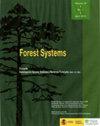Development of SSR loci in Prosopis tamarugo Phillipi and assessment of their transferability to species of the Strombocarpa section
IF 0.7
4区 农林科学
Q3 FORESTRY
引用次数: 3
Abstract
Aims of the study: Phreatophyte species of the Prosopis genus are very important to natural ecosystems in Africa, South America and Asia due to their uses as food and seed sources and in agroforestry. In this research, through next-generation sequencing, we sought to search for and develop SSR markers in Prosopis tamarugo, in addition to assessing their transferability to other species in the Strombocarpa section.Area of study: The study was carried out in species of the Strombocarpa section collected in the “Pampa del Tamarugal”, located in the Atacama Desert (Chile); which is considered the driest and oldest desert on Earth.Materials and methods: The next-generation sequencing for the development of simple sequence repeat (SSR) or microsatellite loci for genetic research in P. tamarugo and their transferability in Prosopis burkartii and Prosopis strombulifera was used.Main results: A total of ~90.000 microsatellite loci in P. tamarugo were found, and a set of 43 primer pairs was used for validating SSR locus amplification. We found a large difference in the percentage of amplified SSR markers between species of the Strombocarpa and Algarobia sections.Research highlights: The present study provides for the first time 24 polymorphic SSR markers for species in the Strombocarpa section, which could be a useful tool for estimating genetic structure, developing breeding programs, quantifying genetic diversity and performing population studies.Keywords: Strombocarpa section; Prosopis tamarugo; Atacama Desert; microsatellites; NGS.柽柳拟南芥SSR位点的开发及其在Strombocarpa区段的可转移性评价
研究目的:Prosopis属的厚生植物对非洲、南美和亚洲的自然生态系统非常重要,因为它们被用作食物和种子来源以及农林业。在本研究中,我们通过下一代测序,寻找和开发了柽鹿Prosopis tamarugo的SSR标记,并评估了它们在Strombocarpa区段中的可转移性。研究范围:研究对象为位于智利阿塔卡马沙漠“Pampa del Tamarugal”的Strombocarpa剖面的物种;这里被认为是地球上最干燥、最古老的沙漠。材料与方法:利用新一代测序技术开发tamarugo的SSR或微卫星位点,研究其在burkartii Prosopis和strombulifera Prosopis中的可转移性。主要结果:在柽柳柽柳中共发现约9万个微卫星位点,用43对引物进行SSR位点扩增验证。我们发现,Strombocarpa和Algarobia两种材料的SSR标记扩增率存在较大差异。研究重点:本研究首次获得了Strombocarpa剖面中24个物种的多态性SSR标记,可为估计遗传结构、制定育种计划、量化遗传多样性和群体研究提供有用的工具。关键词:龙柏剖面;Prosopis tamarugo;阿塔卡马沙漠;微卫星;门店。
本文章由计算机程序翻译,如有差异,请以英文原文为准。
求助全文
约1分钟内获得全文
求助全文
来源期刊

Forest Systems
FORESTRY-
CiteScore
1.40
自引率
14.30%
发文量
30
审稿时长
6-12 weeks
期刊介绍:
Forest Systems is an international peer-reviewed journal. The main aim of Forest Systems is to integrate multidisciplinary research with forest management in complex systems with different social and ecological background
 求助内容:
求助内容: 应助结果提醒方式:
应助结果提醒方式:


